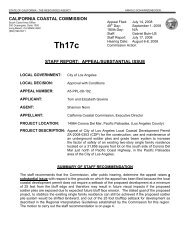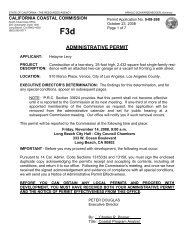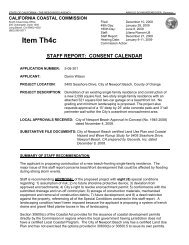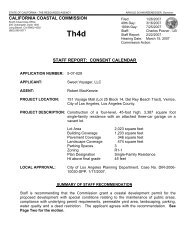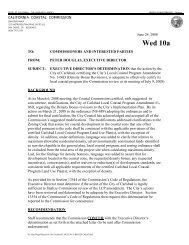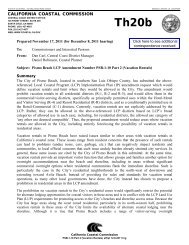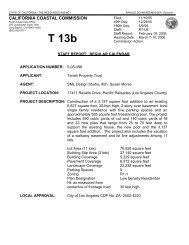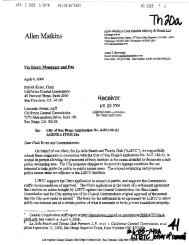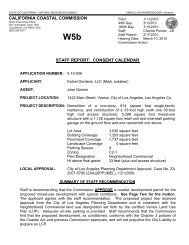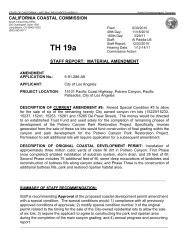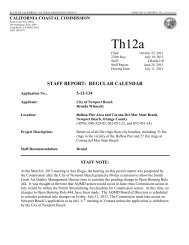Consent Cease and Desist Order No. CCC-13 - State of California
Consent Cease and Desist Order No. CCC-13 - State of California
Consent Cease and Desist Order No. CCC-13 - State of California
Create successful ePaper yourself
Turn your PDF publications into a flip-book with our unique Google optimized e-Paper software.
<strong>CCC</strong>-<strong>13</strong>-CD-02 & <strong>CCC</strong>-<strong>13</strong>-RO-02 (Caribbean)<br />
which would significantly degrade those areas, <strong>and</strong> shall be compatible with<br />
the continuance <strong>of</strong> those habitat <strong>and</strong> recreation areas.<br />
In addition, the City LCP includes the following ESHA related policies:<br />
L<strong>and</strong> Use Element (LUE) Policy 4.5: Consider the environmental impacts <strong>of</strong><br />
development decisions. (Coastal Act/30240, 30241, 30242, 30243, 30244)<br />
L<strong>and</strong> Use Element (LUE) Policy 4.9: Encourage the preservation <strong>of</strong> significant<br />
natural areas as cohesive open space.<br />
Conservation Open Space Element Policy 3.1: ESHAs shall be preserved....<br />
Development in areas adjacent to environmentally sensitive habitat areas shall be<br />
sited <strong>and</strong> designed to prevent impacts that would significantly degrade those<br />
areas, <strong>and</strong> such development shall be compatible with the continuance <strong>of</strong> those<br />
habitat areas. Among the methods to be used to accomplish the siting <strong>and</strong> design<br />
<strong>of</strong> development to prevent ESHA impacts are the practice <strong>of</strong> creative site<br />
planning, revegetation, <strong>and</strong> open space easement/dedications.<br />
Conservation Open Space Element (COSE) Policy 3.3: Encourage retention <strong>of</strong><br />
natural vegetation <strong>and</strong> require revegetation <strong>of</strong> graded areas.<br />
Conservation Open Space Element (COSE) Policy 3.7: Environmentally<br />
sensitive habitat areas (ESHA) shall be protected against any significant<br />
disruption <strong>of</strong> habitat values, <strong>and</strong> only uses dependent on those resources shall be<br />
allowed within those areas except as provided in Conservation Open Space<br />
Element Policy 3.122. Development in areas adjacent to ESHA shall incorporate<br />
buffering design elements, such as fencing, walls, barrier plantings <strong>and</strong><br />
transitional vegetation around ESHAs to serve as transitional habitat <strong>and</strong> provide<br />
distance <strong>and</strong> physical barriers to human intrusion. Variances or modifications to<br />
sensitive resource protection st<strong>and</strong>ards shall not be granted. (Coastal Act/30240)<br />
Conservation Open Space Element (COSE) Policy 6.1: Mitigate the impacts <strong>of</strong><br />
development on sensitive l<strong>and</strong>s such as, but not limited to, steep slopes, wetl<strong>and</strong>s,<br />
cultural resources, <strong>and</strong> environmentally sensitive habitats areas through the<br />
development review process. (Coastal Act/30233, 30240, 30244, 30253<br />
Conservation Open Space Element (COSE) Policy 6.5: Preserve <strong>and</strong> protect<br />
open space, steep slopes, cultural resources, <strong>and</strong> environmentally sensitive<br />
habitat areas through open space deed restrictions, dedication, or other similar<br />
means as a part <strong>of</strong> the development <strong>and</strong> subdivision review process. (Coastal<br />
Act/30250<br />
Conservation Open Space Element (COSE) Policy 7.3: Preserve public <strong>and</strong><br />
private open space l<strong>and</strong>s for active <strong>and</strong> passive recreational opportunities.<br />
(Coastal Act/302<strong>13</strong>)<br />
16



